Trees Birds Mammals Fish Amphibians Reptiles
Wild Algarve
Bookshop
Thelebolus terrestris Alb. & Schwein.
Phylum: Ascomycota - Class: Leotiomycetes - Order: Thelebolales - Family: Thelebolaceae
Distribution - Taxonomic History - Etymology - Identification - Culinary Notes - Reference Sources
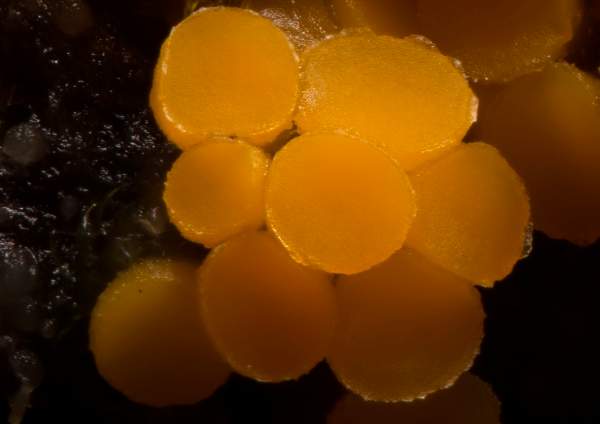
The genus Thelebolus comprises a group of simple disc-likel ascomycetes with small fruitbodies and clavate asci. In many of the species each ascus contains eight ascospores, but there are some members of this genus whose asci produce more than 2000 spores. Mostly these little fungi grow on various kinds of dung or rotting vegetation, often on disturbed soil beside woodland
paths. Thelobolus terrestris is fairly typical of the genus, producing small orange disc-like fruitbodies
Distribution
An extreemely rare find in Britain and Ireland, Thelebolus terrestris occurs also throughout most of western Europe, from Scandinavia (where it is a relatively common sight on deer droppings) right down to northern Spain. There are references to this species occurring in Russia and also in Canada.
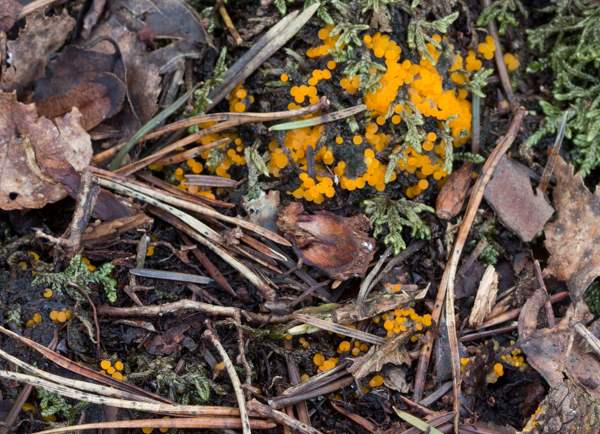
Taxonomic history
In 1805 this ascomycete fungus was described by German mycologist Johannes Baptista von Albertini (1769-1831) and German-American Lewis David von Schweinitz (1780-1834); they gave it the scientific name Thelebolus terrestris.
Synonyms of Thelebolus terrestris include Byssonectria terrestris ( Alb. and Schwein) Pfister and Sphaerobolus terrestris (Alb. & Schwein.) W.G. Sm.
Etymology
The specific epithet Thelobolus may come from the Greek words thelo- meaning a nipple and -bolus meaning a lump or a clod of earth.
Much more straightforward is the specific epithet terrestris which means of the earth or the soil, and this ascomycete does indeed grow on soil.
Identification guide
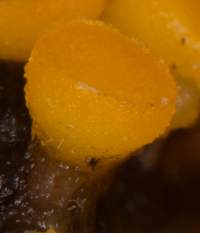 |
Ascocarp (fruitbody)
These bright yellow to orange fungi start off as tiny spheres and develop into bowl-shaped fruitbodies, typically up to 3mm across but exceptionally to 5mm. They have smooth hymenial or spore-producing upper surfaces, while the infertile (outer edge of the cup-shaped fruitbodies) surface is slightly paler
and scurfy.
The short-stemmed cups are initially round but develop
irregular margins where they push up against other fruitbodies. |
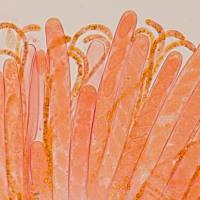 |
Asci
185-200 x 10-13µm, with eight spores per ascus.
Paraphyses
Narrow, curled at tips.
Paraphyses are structures of sterile tissue between the asci on the hymenial surface.
|
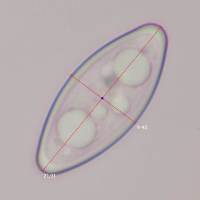 |
Spores
Ellipsoidal, with a coarsely reticulate surface, 17-24 x 9-11µm (including ornamentation); spores usually containing two small oil drops, sometimes with thorn-like projections at each end.
Spore print
White. |
Odour/taste |
Not distinctive. |
Habitat & Ecological role |
Saprobic, on well-rotted deer droppings among plant debris, often beside disturbed paths; this species has also been found growing on burnt conifer wood. It is reported to favour high nitrogen levels and a high pH. |
Season |
Unclear as so few collections have been recorded, but related species can be found all year round but particularly in springtime. |
Similar species |
Several other ascomycetous disc fungi also colonise animal dung. Few can be identified from macroscopic features alone, and so microscopic examination of asci, spores and other cell structures is usually necessary. |
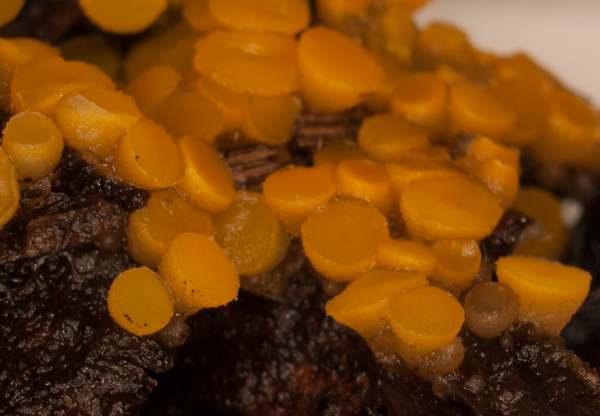
Culinary Notes
Toxicity uncertain, but these cup fungi are far too small to be of any culinary interest.
Reference Sources
Dennis, R.W.G. (1981). British Ascomycetes; Lubrecht & Cramer; ISBN: 3768205525.
Breitenbach, J. & Kränzlin, F. (1984). Fungi of Switzerland. Volume 1: Ascomycetes. Verlag Mykologia: Luzern, Switzerland.
Medardi, G. (2006). Ascomiceti d'Italia. Centro Studi Micologici: Trento.
Dictionary of the Fungi; Paul M. Kirk, Paul F. Cannon, David W. Minter and J. A. Stalpers; CABI, 2008
Taxonomic history and synonym information on these pages is drawn from many sources but in particular from the British Mycological Society's GB Checklist of Fungi.
Acknowledgements
Pictures on this page are shown by courtesy David Kelly, who found and photographed Thelebolus terrestris in the New Forest, Hampshire, in February 2013.
Top of page...
Fascinated by Fungi. Back by popular demand, Pat O'Reilly's best-selling 450-page hardback book is available now. The latest second edition was republished with a sparkling new cover design in September 2022 by Coch-y-Bonddu Books. Full details and copies are available from the publisher's online bookshop...